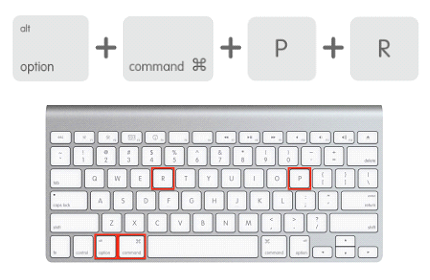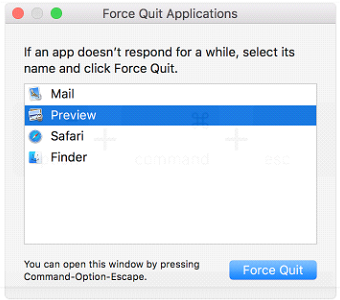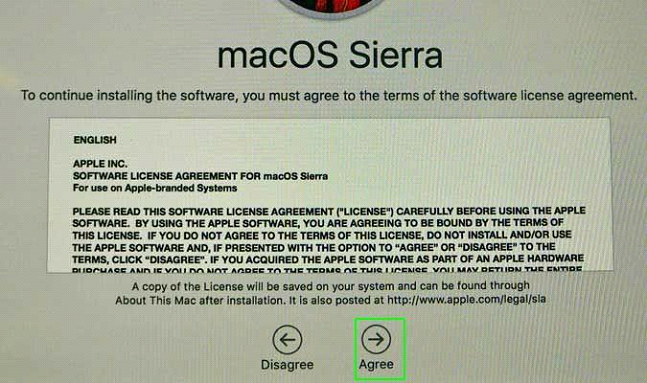1. Introduction and Quick Solutions
When a MacBook freezes, macOS fails to provide its users with access to any system component. A particular application may freeze as well, becoming unresponsive while the rest of the system stays up and running.
A common way to handle a fully frozen system is to restart your MacBook. A hard restart is available with the power button. Its milder version is available via the Control-Command-Power key combo. The latter might fail if the glitch is severe, though. Both workarounds will close all the applications and restart your system, so you don’t get a chance to learn the underlying cause. That’s a straightforward technique enabling immediate relaunch so that you can keep using your computer.
Tip 1: Although the system does not seem to respond to any button hits or mouse clicks, you may still be able to restore proper operation of your MacBook. Use Command-Option-Escape.
This is going to open the Force Quit Applications menu. Once in the Force Quit window, you will see the list of applications currently running. Quit the one that does not respond to routine closing commands.
 Fig. 1. Command-Option-Escape to avoid hard restart with Force Quit Applications
Fig. 1. Command-Option-Escape to avoid hard restart with Force Quit Applications
A freezing MacBook is just as readily available for a restart as a Windows PC is. In most cases, a MacBook restores its normal operation as soon as you quit the app that isn’t responding. Otherwise, you may have to resort to a hard restart.
Tip 2: If you are about to kill the application currently freezing you up or otherwise annoying you, use the following key combination: Command-Shift-Option-Escape. Hold the keys for at least 3 seconds.
The operating system will terminate the application currently in front of you. This allows you to avoid browsing to any tabs or leveraging the Terminal.
 Fig. 2. Command-Shift-Option-Escape to kill the app in front of you without further ado
Fig. 2. Command-Shift-Option-Escape to kill the app in front of you without further ado
2. Underlying Causes and Respective Overhauls
By fixing a frozen MacBook, you will prevent further system failures from occurring. The right troubleshooting mechanism will sort out the root cause rather than yield a one-time result. Let’s take a dive into what might cause your device to act up this way.
Before I proceed, you may want to get a quick answer for one nontrivial question: does Safe Quit affect your MacBook’s performance or data? Basically, the answer is ‘No, it does not’. However, the applications that you force to quit are unable to retain the data they have not saved yet. You might want to let such apps complete their operation normally.
Quick termination does not affect the performance of your device. It does not improve it either. This is your urgent measure.
We tend to get used to the devices around us. As we use most of them for a long time, we may nurture an illusion that they aren’t error-prone. Oddly enough, this misconception holds true for Macs to a significant extent. The truth is that there are multiple reasons behind a lagging and unresponsive MacBook.
You may have installed something that’s too big for it to digest. Your MacBook is a powerful machine that can run highly demanding software. Being such a capable processor, though, it does not get its CPU capacities enhanced in any way. Meanwhile, the system requirements of various applications may be updated over time. Your MacBook may freeze as its resources simply don’t suffice, even though they are fairly vast. Its computation power might fail to catch up with the growing demands of the ever-evolving and emerging software.
Apart from the freezing impact, over-demanding software slows down your MacBook. Run one application at a time if the resources it consumes are about to exceed the capacity of your system.
Your MacBook may run much slower if the operating system gets clogged. This congests the resources otherwise available for day-to-day activities. You can give your MacBook’s performance a boost by making its resources fully available to the macOS. Both manual and automated techniques can do the trick. The best solution would be an application cleaning your system from junk while advising you as its administrator on the items to be removed.
Excessive software demands for system resources and clogged operating system reduce your MacBook’s efficiency. The resulting scarcity is a common cause for the MacBook freezing problem.
Malfunctioning software and poor system settings also cause slowdown and freezing issues. If an application is causing recurrent Mac failures and freezes, it needs to be fixed. You may have to reinstall or update it. Prior to applying such measures, it’s a good idea to check whether the software runs flawlessly on a MacBook. Unfortunately, general statements regarding compatibility aren’t necessarily a guarantee. Consult dedicated forums and experts. As a general rule, use applications published by trusted vendors and remove the applications you cannot rely on.
Another common source of MacBook freezing issues pertains to explicitly malicious activities. For instance, certain websites may generate redirects and unauthorized downloads. Your system freezing in response is not the worst upshot. Things get really out of hand if viruses end up on your device in the aftermath of such dodgy web surfing. True, viruses target Windows PCs way more often than they hit Macs. In general, a Mac is less susceptible to cyber-attacks. However, as of now it is not a virus-proof system at all.
In order to avoid website-borne and virus-backed system freezes, make sure your Mac is properly protected. Many experts still believe the default security of Apple devices is reliable enough to keep most menaces at bay. Opposite opinions are surfacing as well, but they are largely fueled by unscrupulous security software vendors. One way or another, proper protection of your Mac entails lower risk of slowdowns and freezes caused by malware.
3. Recap and Conclusions
Apple devices are less exposed to the freezing problem than those running Microsoft’s operating system. However, both share the same root causes and tools. There are three major triggers freezing your MacBook:
- Lack of capacity (RAM, etc.) due to growing software demands and junk items clogging the system.
- Malfunctioning software causing major system errors.
- Malicious activities of shady websites you visit and harmful code you install.
Limited options are available for a Mac device to build up its default resources. The new generation of Apple products have their RAM soldered to the motherboard. Therefore, if a lack of capacity is causing your MacBook to freeze, then you should optimize the usage of its available resources and limit their consumption. Clean junk files and ensure the software and system settings allocate a maximum of resources to meet the ongoing demands of the apps running on your machine. You may want to restrict the number of apps running at once. A tried-and-tested system optimization tool is welcome, too.
Malfunctioning software and poor system settings constitute another known source of the freezing quandary. If faulty system settings are the case, the common workaround is to tweak the NVRAM and PRAM. As for the malfunctioning apps, consider removing or fixing the items that repeatedly cause system freezes. This particular trigger often has to do with malware interference and other malicious activities wreaking havoc with the system.
Whether with or without deliberate intention, poor quality and potentially harmful websites and applications thwart normal operations of your macOS. Your Mac’s native security provides a decent level of protection against malicious invasions. Ensure you have your device protected by at least its default solutions. Consider enhancing your Mac’s security with third-party software.
FAQ:
– My Mac freezes on startup
First off, startup issues put your data at risk. There is no guarantee that you will successfully restore access to your system. To be on the safe side, be sure to maintain a backup of the valuable data you store on your MacBook. Otherwise, you may simply lose those files someday.
There are multiple reasons for your Mac to freeze on startup. Here’s a case-by-case guidance in this regard.
Trigger 1: Faulty NVRAM and/or PRAM
RAM (random-access memory) does not totally disappear at reboot. It partly survives in the form of NVRAM (nonvolatile random-access memory) and PRAM (Parameter RAM). Meanwhile, it is the reboot-surviving RAM that may cause system freezes.
Solution for Trigger 1: Reset NVRAM and/or PRAM
There is a single procedure for resetting both NVRAM and PRAM.
- Shut down your Mac.
- Start it again and press the following combination: Option-Command-P-R.
 Fig. 3. Option-Command-P-R to reset NVRAM and PRAM
Fig. 3. Option-Command-P-R to reset NVRAM and PRAM
Sometimes you need to restore the NVRAM to get your computer functioning again. Reset the NVRAM by powering down the MacBook, then start it back up and immediately hold down the “Command-Option-P-R” keys simultaneously. Stop holding the keys once you hear the startup sounds for the second time.
Trigger 2: SMC (System Management Controller) performs a range of background activities that are critical for normal operation of your MacBook. You may need to reset SMC if your system freezes on startup.
Solution for Trigger 2: reset SMC
Early MacBook versions have removable battery. Later versions have their battery sealed. SMC resetting differs between the two types.
For MacBook with a removable battery:
- Shut down your Mac.
- Take out the battery.
- Keep pressing the power button for at least five seconds without inserting the battery.
- Insert the battery back in.
- Turn on your Mac as usual by pressing its power button.
For MacBook with a non-removable battery:
- Shut down your Mac.
- Connect the power adapter to your Mac. If it’s already connected, make sure it stays that way.
- Press and hold Shift-Control-Option keys.
- Simultaneously with the step 3, strike and keep tapping the power button. Note the MacBook Pro’s Touch ID is also its power button.
- The steps 3 and 4 take place simultaneously for at least 10 seconds.
- The steps 3 and 4, if completed successfully, reset SMC.
- Following a successful reset, start your MacBook in a normal way.
Trigger 3 refers to a range of issues covered by the standard response available with the Safe Mode tools. That is to say, Safe Mode includes disk scan and fix for major issues in the operating system. This method, last but not least, may enable access to your system where the normal boot fails.
Solution for Trigger 3: Start in Safe Mode
- Shut down your MacBook.
- Start it again by pressing the power button. Note the MacBook Pro’s Touch ID is also its power button.
- Once you hear the startup sound, hold down Shift until the Apple logo appears.
- That’s it… unless you would like to make sure you are running in Safe Mode.
Unlike the Windows scenario, there is no clear sign on the surface. To ensure your macOS is running in Safe Mode, go to the Apple logo in the upper left-hand corner of your display. Proceed to About This Mac and then go to System Reboot. Finally, choose Software and in the Boot Mode section ensure the Safe Mode is on (if it is not, this says Normal Mode).
– How to force quit apps on a Mac when it’s frozen?
Use Command-Option-Escape.
 Fig. 4. Command-Option-Escape to launch Force Quit Applications menu
Fig. 4. Command-Option-Escape to launch Force Quit Applications menu
This should launch the Force Quit Applications menu that displays the list of applications currently running.
 Fig. 5. Force Quit Applications menu
Fig. 5. Force Quit Applications menu
Kill the unresponsive apps or any apps annoying you.
In case your MacBook is persistently freezing regardless, a hard restart is available with the power button. Its milder counterpart may be available via Control-Command-Power keys. Note the MacBook Pro’s Touch ID is also its power button.
– How to restart a MacBook Air?
Use Control-Command-Power keys. Press and hold them until your MacBook Air reboots.
Sometimes this does not work. If so, you will need to turn off the device by holding the power button until your MacBook Air switches off.
Note the MacBook Air’s power button is its Touch ID.
Forcing restart for your MacBook usually takes place where other measures fail. You may rather want to unfreeze macOS with the Force Quit feature.
– How to reset a MacBook Pro?
MacBook Pro resetting involves data erasure, a complete one. You want to keep your data, don’t you? If so, ensure proper backup before proceeding any further.
- Turn on your MacBook Pro.
- Press and hold Command and R keys.
- The Apple logo should appear. Release the Command and R keys.
- The introduction window prompts you to select your language. Go ahead and pick one.
- In the macOS Utilities window, select Disk Utility.
 Fig. 6. masOS Utilities menu
Fig. 6. masOS Utilities menu
- In the window that will appear, select the disk to be erased. Make your choice out of the options available in the left-hand section of the screen.
- Click the Erase button at the Disk Utility sidebar to delete all the data from the disk you have selected.
 Fig. 7. Clicking Done as the disk erasing process is completed and new disk is to be created
Fig. 7. Clicking Done as the disk erasing process is completed and new disk is to be created
- Click Done in the progress bar dialog when the operation is completed.
- At the upper menu, go to Disk Utility and select Quit Disk Utility.
- This returns you to the macOS Utilities.
 Fig. 8. Back in the macOS Utilities to opt for Reinstall macOS
Fig. 8. Back in the macOS Utilities to opt for Reinstall macOS
- Opt for Reinstall macOS. Doing so will enable the Continue button that you need to click.
- Clicking Continue produces another popup introducing the macOS version you are about to install. Click Continue once again to proceed.
 Fig. 9. Clicking Continue in the installation window to set up the installation of macOS
Fig. 9. Clicking Continue in the installation window to set up the installation of macOS
- The next window contains the terms of the software license agreement. Click Agree to proceed.
 Fig. 10. Clicking Agree to accept the software license agreement
Fig. 10. Clicking Agree to accept the software license agreement
- This generates a popup letting you know which disk the operating system will be installed on.
- The MacBook Pro will restart before the installation is launched. The process may take a while.
- Once the installation is complete, another restart takes place. That’s it – your MacBook Pro has been reset.












